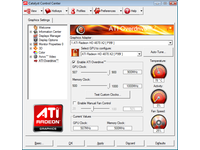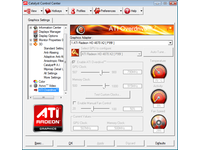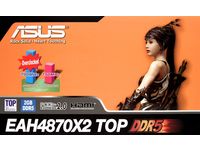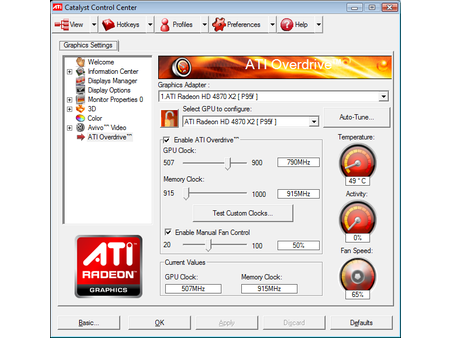Radeon HD 4870 X2: Four Cards Compared
Asus Radeon HD 4870 X2 Top (EAH4870X2 TOP/HTDI/2G/A)


The TOP model is shipped with higher-than-reference clock frequencies. The standard for the GPU is 750 MHz and Asus increases this to 790 MHz. The graphics memory speed is only slightly increased, from the standard of 900 MHz to 915 MHz (DDR5 frequency 3660 MHz).
For this comparison, we don’t do additional overclocking because the overall gain turns out to be rather low. But if you want to take the card to its limits, you can get quite a bit more out of the TOP model. The test card can easily do a GPU frequency of 822 MHz, which is the best value in the test group. A nice addition is the extension of Overdrive . Asus increases the usual limit in the driver from 800 MHz to 900 MHz. This option functions independently of any particular software version, because it is available in the Catalyst 8.10 from AMD’s homepage.
The graphics memory has similar overclocking potential. The reference speed is 900 MHz and Asus sets the TOP model to 915 MHz. But our test card can easily do a stable 990 MHz—again the best value in the test group. As long as you install only Catalyst 8.10, the fan profile works without a problem, with the fan adjusting its speed according to the clock speed. With the additional overclocking, it spun at 3,400 RPM to maintain 85°C. When you use the preset Asus settings (790 and 915 MHz), the temperature can rise to 89 or 92 degrees, which is due to the lower fan speed of 3,000 RPM.
If you install the Catalyst 8.10 with the Asus Smart Doctor that comes included, the fan profiles get screwed up. In 2D mode the fan speed rises from 27% (standard) to 65%, and the noise level rises from a quiet 37.0 dB(A) to a loud 46.2 dB(A). These values sound alright, but you can see the issue when looking at the high temperatures in 3D mode. The fan doesn’t turn on reliably until the temperature reaches 96°C. It’s an inconsistent issue at best, though, as one of the five tests did see the fan turn on at a correct time.
Asus didn’t put in games or additional software. Instead, the company gives you two power adapters, and the 8-pin adapter is rather rare. You get HDMI through using the DVI adapter, and it comes with a bridge for Crossfire. Finally, you get a leather bag for CDs and DVDs as a special extra.
Naturally, despite all of our praise for this board’s overclocking headroom, bear in mind that Asus is only going to cover your card with a warranty if it wasn’t fried in the line of duty. Overclocking can be risky, especially at the temperatures we’re talking about here. You pay for Asus’ additional clock speed, plus the luxury of factory coverage. Taking the card past that point is at your own risk.
Asus Radeon HD 4870 X2 Top
Get Tom's Hardware's best news and in-depth reviews, straight to your inbox.
As a TOP model, the card comes overclocked, but it can take significantly more tweaking before showing instability—it has the largest overclocking potential in the test group with a maximum of 822 MHz (GPU) and 990 MHz (memory). As long as you run the card with only Catalyst 8.10, the fan profiles work well; problems occur only when you install the Asus Smart Doctor.
- Advantages
- Disadvantages
- Best overclocking potentialOutstanding fan profiles with Catalyst 8.10Adapter for 8 pin power supply
- Smart Doctor + Catalyst 8.10 causes errors
Current page: Asus Radeon HD 4870 X2 Top (EAH4870X2 TOP/HTDI/2G/A)
Prev Page Radeon HD 4870 X2 Specifications and Ports Next Page Software Asus Radeon HD 4870 X2 Top-
Not only do we have four super-fast Radeon HD 4870 X2s to test, but also a list of 31 other graphics configurations including CrossFire and SLI setups. If you're in the market for AMD's fastest card available, you'll want to see this.Reply
Radeon HD 4870 X2: Four Cards Compared : Read more -
neiroatopelcc "Because of accessories and price, Sapphire is our best-buy recommendation."Reply
One slight warning about sapphire though. If you have problems, don't expect their support team to help you before you've solved the problem yourself!
I made a ticket regarding some issues with my 4870 on august 7th, and received a reply on the 26th of september! That's 46 days to address an error they simply stated would go away with a bios upgrade from their homepage!
As for the article, I actually liked the detailed driver errors they encountered. Not that I liked the errors themselves, but I liked them being explained. Usually you just read 'after spending some hours resolving driver errors ....' without getting any wiser. -
Pei-chen Wow, AMD cards consume power like a Detroit SUV. I like Nvidia GTX 2xx series’ Toyota Prius like efficiency at idle.Reply -
ilovebarny Why didnt they use the GTX260 Core 216? its like way better than the regular GTX260. And i just read yesterday that Nvidia was only going to make GTX260 Core 216 now. http://www.fudzilla.com/index.php?option=com_content&task=view&id=10497&Itemid=1Reply -
enforcer22 Pei-chenWow, AMD cards consume power like a Detroit SUV. I like Nvidia GTX 2xx series’ Toyota Prius like efficiency at idle.Reply
Hmm your right. Power house vs crippled mouse.. yeah your analagy sucked im sure mine did to but all i saw from what you typed was i like weak stuff dont give me more power. -
bdollar seems to me if you are going to be comparing the highest end cards and even crossfire them for 4x you would have the highest resolution as one of the options. i would think people considering going x2 in crossfire would consider a 30" screen.Reply
don't get me wrong, i liked the article but would have liked to have seen the resolution spectrum hit the top. -
It's nice to see the 9800GX2 included in the tests. I was considering the 4870x2 due to all the rave reviews but they never had the comparison like this against my current 9800GX2. I won't be getting new card anytime soon it seems. Thanks.Reply



